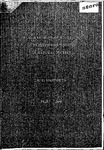Measurement and modelling of uranium and thorium in natural waters
| dc.contributor.author | Unsworth, Ernily Rachel | |
| dc.contributor.other | Faculty of Science and Engineering | en_US |
| dc.date.accessioned | 2012-08-10T14:48:51Z | |
| dc.date.available | 2012-08-10T14:48:51Z | |
| dc.date.issued | 2001 | |
| dc.identifier | Not available | en_US |
| dc.identifier.uri | http://hdl.handle.net/10026.1/1145 | |
| dc.description.abstract |
Uranium and thorium are the only elements in the actinide series which naturally occur in the environment in sufficient amounts for practical extraction. They are both radiotoxic and chemotoxic to humans due to the effects of the ionising radiation produced by their radioactive decay, the decay of their daughter products, and due to the chemical toxicity resulting from absorption into the body. Thus it is important to be able to quantitatively determine the levels of uranium and thorium in the environment. Measurement of low levels of uramum and thorium in the presence of high levels of inorganic and organic matrix components has been achieved by coupling on-line solid phase extraction (SPE) with inductively coupled plasma mass spectrometry (ICP-MS) detection. This allowed direct analysis of water samples without any sample pre-treatment offering detection Umits of 0.01 ng ml uranium and 0.006 ng ml thorium. However, in many studies not only do the total levels of uranium and thorium need to be determined, but also their speciation, since this can effect their toxicity and mobility in the environment. An on-line uranium speciation method has successfiilly been developed using a chelating resin micro-column attached to an ICP-MS. This method has been applied to the analysis.pf natural water samples (from Dartmoor, Devon, UK) and the results obtained indicate that the uranium-organic species such as those formed with humic substances are the major species present. A comparison of the pH and level of organic carbon (in a range of natural and synthetic water samples), with the level of uraniumorganic species indicates that the organic carbon concentration is a controlling factor in determining the level of uranium-organic species formed. The kinetics of dissociation of uranium and thorium-humic substance species was also studied. The slow rate of dissociation, observed indicates that once the uranium-humic species have formed these species could remain in the environment for some time. These studies also indicate that even if a change in environmental conditions affected the speciation,it would take time before the uranium and thorium-humic species dissociated and the system equilibrated to a new speciation profile. Two computer programs (WHAM and PHREEQCI) were used to model uranium and thorium speciation in aquatic systems. The Nuclear Energy Agency Thermocheraical Database Project (NEA-TDB) values were incorporated into both programs, as differences in the thermodynamic data provided with the two programs were found to have a major effect on the predicted speciation profiles produced by the two programs. Using the NEATDB values, both programs produced similar inorganic speciation profiles for a given aqueous system but when an organic carbon component was added to the system the two programs produced different predictions for the level of uranium-organic species. This reflected the different organic speciation components utilised within the two programs. WHAM uses a discreet site electrostatic humic substance model and PHREEQCI uses an analogy type model based on a 'model fulvic acid' dataset. A comparison of model predictions with experimental data for the same water sample, indicates that the WHAM program produces closer predictions to the experimental results than the PHREEQCI program. A fiirther study of the WHAM program, using synthetic water solutions with a range of pH, organic carbon and uranium concentrations, indicates that the program has a bias towards low predictions at high pH and low organic carbon concentrations (pH>7, organic carbon < 0.5 ug ml), but wil function satisfactorily within the range of conditions found in the natural (Dartmoor) water samples. The results of these studies should aid environmental investigation based on uranium and thorium where model predictions are to be used. | en_US |
| dc.description.sponsorship | British Geological Survey | en_US |
| dc.language.iso | en | en_US |
| dc.publisher | University of Plymouth | en_US |
| dc.title | Measurement and modelling of uranium and thorium in natural waters | en_US |
| dc.type | Thesis | |
| plymouth.version | Full version | en_US |
| dc.identifier.doi | http://dx.doi.org/10.24382/1482 |
Files in this item
This item appears in the following Collection(s)
-
01 Research Theses Main Collection
Research Theses Main


